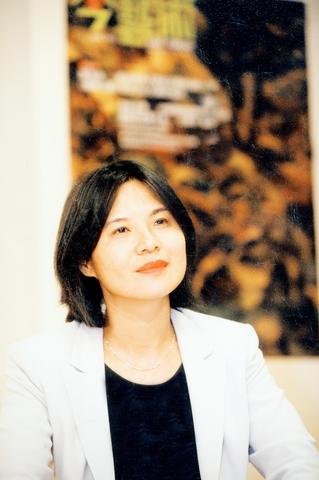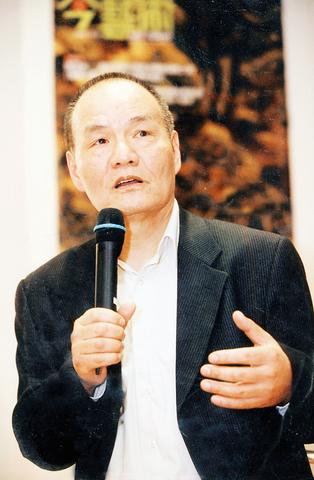Aspiring to create what Flash Art magazine is to contemporary European art, Katy Chien
The characters for "art" become Yishu in pinyin, giving the Vancouver-based magazine a Chinese flavor.

"The staff in Taiwan at first tried to make the title sound `western.' These titles were an easy-to-confuse bunch, like `art-something' or `something-art.' It was the staff in Vancouver, many of them Chinese Canadians, that gave the magazine a very Chinese identity by calling it `Yishu,'" Chien said in an interview with Taipei Times. "I hope that in the future, foreigners will come to recognize this word as meaning `art,' just as all non-Chinese know the word `tofu.'"

Upsurge in interest
The timing of Yishu's launch comes hot on the heels of an upsurge in international interest in contemporary Chinese art, which, according to Chien, almost always refers to mainland Chinese and not Taiwanese art.
"When foreigners talk about contemporary Chinese art, they are talking only about mainland. Taiwan has no voice on the international stage," Chien said. "On all the major art occasions in the world, ... the Documenta, for example, how many artists from Taiwan have been recognized there? Unfortunately, there are international politics at play here. That's why we need to make more of an effort to promote Taiwanese art. And that's part of the reason for launching the magazine."
"For English information on mainland art, people have Chinese-art.com [a comprehensive English-language Web site]. We don't have something like that about contemporary art in Taiwan" Chien said.
With this in mind, Yishu flies the `Chinese art' instead of `Taiwanese art' flag. The premier issue of Yishu covers mainland Chinese artists and Chinese immigrant artists in Canada and the US as well as artists from Taiwan. "Frankly, a magazine exclusively about Taiwanese art would draw very few people's attention. We would rather mix all the Chinese artists together and leave it to the reader to discover that a particular artist who interests them is from Taiwan," Chien said.
Currently publishing Art & Collection: Ancient and Art & Collection: Contemporary, Chien's company has thrived during the present recession, thanks to a strategy of catering to different groups with different products.
The two Art & Collection magazines used to be one monthly published by Wealth magazine company. At that time, it targeted art-collectors market, giving commercial works more coverage. In 2000, it became independent from Wealth, and at the same time split into two monthlies, one focusing on antiques and the other on contemporary art, with both increasing the coverage of exhibitions and other art events. Since their separation, the two have seen a significant rise in advertisement revenues compared with CANS and Artist, the other two art magazines in Taiwan. Now Chien hopes targeting another niche market will work for Yishu as well.
For Shengtian Zheng (鄭勝天), the magazine's managing editor who emigrated from Taiwan to Canada several years ago, that market means intellectuals worldwide. "The [appreciation of] contemporary art in China is growing rapidly. Despite such developments, there has been remarkably little in terms of a corresponding amount of theoretical writing. We realized there was a need for a serious and intellectually inclined journal to address this deficiency," Zheng said in an e-mail to the Taipei Times.
Developing his idea with Chien, Zheng came up with Yishu as an answer to the lack of in-depth material on contemporary Chinese art for non-Chinese readers.
About face
Maybe it was the Chinese concern regarding face that made Chien give meticulous attention to Yishu's appearance -- the magazine's impeccable design is a step up from her two Art & Collections.
"We want this publication to show exquisite taste in content, layout and printing," Chien said, pointing to the neat cover design of monochrome red and the pleasantly clean fonts and layout. The often irrelevant photos of artists and scholars during meetings, common in Chinese-language art publications, are reduced to thumbnail size, making room for cleaner text format. However, a casual glance of the pages offers too few explanatory pictures.
"In the future, the volume will be more massive with more and bigger photos. When it comes to works of art, a photo speaks much more than text," Chien said.
Yishu may not need too much text but it needs to be well-written. It took Zheng more than an year to recruit writers and editors with native-speaker-level English who are also versed in contemporary Chinese or Taiwanese art. The staff are all part-timers with jobs in other fields. "So that their horizons are broader," Chien explained.
That broader horizon is what Yishu wants to offer. The first issue roughly focuses on Chinese culture vs contemporary art, with a large portion devoted to transcriptions of interviews with and panel discussions among artist, critics, curators and others.
Although aspiring to be an "academic journal reflecting the scholarship in the field of contemporary Chinese art and culture," in Zheng's words, Yishu is also trying to be accessible to the general public. As the magazine's premiere issue arrives at collectors' homes and college libraries in New York and London, it remains to be seen if it will stay there.

In the March 9 edition of the Taipei Times a piece by Ninon Godefroy ran with the headine “The quiet, gentle rhythm of Taiwan.” It started with the line “Taiwan is a small, humble place. There is no Eiffel Tower, no pyramids — no singular attraction that draws the world’s attention.” I laughed out loud at that. This was out of no disrespect for the author or the piece, which made some interesting analogies and good points about how both Din Tai Fung’s and Taiwan Semiconductor Manufacturing Co’s (TSMC, 台積電) meticulous attention to detail and quality are not quite up to

April 21 to April 27 Hsieh Er’s (謝娥) political fortunes were rising fast after she got out of jail and joined the Chinese Nationalist Party (KMT) in December 1945. Not only did she hold key positions in various committees, she was elected the only woman on the Taipei City Council and headed to Nanjing in 1946 as the sole Taiwanese female representative to the National Constituent Assembly. With the support of first lady Soong May-ling (宋美齡), she started the Taipei Women’s Association and Taiwan Provincial Women’s Association, where she

It is one of the more remarkable facts of Taiwan history that it was never occupied or claimed by any of the numerous kingdoms of southern China — Han or otherwise — that lay just across the water from it. None of their brilliant ministers ever discovered that Taiwan was a “core interest” of the state whose annexation was “inevitable.” As Paul Kua notes in an excellent monograph laying out how the Portuguese gave Taiwan the name “Formosa,” the first Europeans to express an interest in occupying Taiwan were the Spanish. Tonio Andrade in his seminal work, How Taiwan Became Chinese,

Mongolian influencer Anudari Daarya looks effortlessly glamorous and carefree in her social media posts — but the classically trained pianist’s road to acceptance as a transgender artist has been anything but easy. She is one of a growing number of Mongolian LGBTQ youth challenging stereotypes and fighting for acceptance through media representation in the socially conservative country. LGBTQ Mongolians often hide their identities from their employers and colleagues for fear of discrimination, with a survey by the non-profit LGBT Centre Mongolia showing that only 20 percent of people felt comfortable coming out at work. Daarya, 25, said she has faced discrimination since she